 Dingli Local Council – Spring 2013
Dingli Local Council – Spring 2013
Discovering wild flowers at Dingli Cliffs
Alfred E. Baldacchino
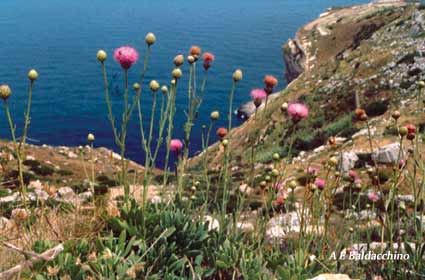
Dingli Cliffs rise from the depths of the sea to a height of 253 meters above sea level. Their majestic height, facing North Africa, forms the highest point in the Maltese Islands.
Although exposed to the winds and sea spray, Dingli Cliffs offer a unique natural environment which can also be regarded as one of the richest in the Maltese islands. It embraces sea cliffs, garigue, and maquis, with adjacent woodland at Buskett on the inland side. A walk along these majestic cliffs brings one face to face with the beauty and wonders of nature, whatever the season of the year. A very brief look will give an idea of the richness of the place and the natural wealth there is to discover.
MALTESE ROCK-CENTAURY – Widnet il-Baħar
Without doubt, a must see at Dingli Cliffs is the rare, evergreen Maltese Rock-Centaury. This wild plant is an endemic species, that is, it is found growing wild only in the Maltese islands and nowhere else in the world. Even in Malta, the plant’s distribution is limited to the southern coastal cliffs of the islands. It flowers between May and July. It was declared Malta’s national plant in 1971. The Maltese Rock-Centaury is threatened by the destruction of its natural habitat mainly through quarrying.
It is listed by the IUCN (International Union for the Conservation of Nature) as a critically endangered species and is also listed as an Annex II species in the European Union Habitats Directive. It is also protected by Maltese legislation.
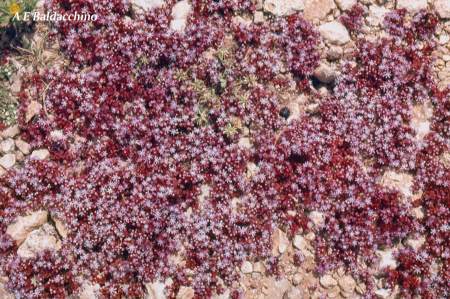
AZURE STONECROP – Beżżulet il-Baqra
The exposed garigue rocks can lead one to think that they are just bare rocks. A closer look at such habitat, especially where some water accumulates during the rainy season, reveals the spread of a low lying succulent plant, the Azure Stonecrop that only grows 6 to 7 mm in height. With the advent of summer, the leaves of the Azure Stonecrop turn red, with small white flowers having sky blue tips. These can be seen from March to May. The Azure Stonecrop is abundant in the Maltese Islands.
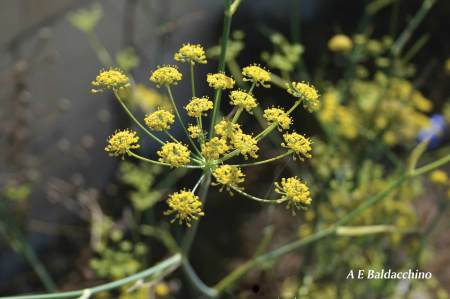
FENNEL – Bużbież
Fennel is a very common plant that can be found along waysides, disturbed ground and garigue. It can reach heights up to 250 cm and having thin segmented leaves. It flowers from May to October bearing yellow bunched flowers in the form of an umbrella, mainly in summer. The leaves are very aromatic. Our forefathers, and today some still do, used fennel seeds as a seasoning to oven-baked potatoes and to flavour meat. It was also believed to help against digestive problems and nausea. It is said that its leaves placed among clothes in drawers deter insects. Overseas, liqueurs and perfume essence are also made from fennel. The flowers of the wild fennel attract a number of insects, the most noticeable being the Swallowtail Butterfly. This endemic subspecies lays its eggs on the tender shoots of the fennel. The green-coloured caterpillar decorated with orange and white dots is also a sight to behold. Eventually it pupates and develops into a beautiful yellow-and-black butterfly, the largest in the Maltese Islands with a wing span of up to 65 to 88 mm.
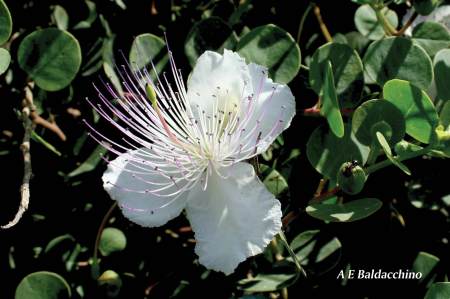
CAPER – Kappara
The Caper is a common wild plant which can also be found along Dingli Cliffs. It is a sprawling greyish shrub with thick rounded leaves. The 5 to 7 cm white flowers each have four white petals and a number of purple stamens. They also have a delicate odour and are in bloom from April to September. The caper is salt-tolerant and can grow on sea-cliffs. It is also widely distributed through the Mediterranean. A local tradition is collecting and pickling the flower buds in brine and vinegar to be added to Maltese salads and sauces. It has a sharp piquant flavour affecting taste or smell with a sharp acid sensation. It adds a peculiar aroma and saltiness to food such as fish, meat, salads, pasta sauce, and pizza. It contributes to classic Mediterranean flavours which also include olives, anchovies, artichokes, and garden rocket. It is said that the caper plant can be used as a poultice – the soft moist mass of the plant, often heated, is spread on cloth over the skin to treat aching, inflamed or painful parts of the body, especially inflammations of joints such as those of the feet and hands. Leaves are also crushed and put on painful areas of hip gout. Furthermore, a decoction – an extraction obtained by boiling leaves or roots – is used on skin rashes.

TREE SPURGE – Tengħud tas-Siġra
The Tree Spurge is a frequent dense shrub which grows on valley slopes, on garigue, and also adapts to difficult sites. This shrub can reach a height of 2 m. It is a deciduous plant and loses all its leaves in summer. After the first rains, the green-bluish leaves begin to appear. It is covered in yellow flowers from December to May. With the approach of summer it turns from reddish-orange to rosy-bronze. Its dried leaves fall off completely in summer, as it waits for the first autumn rains. The Tree Spurge has a poisonous milky sap which is also a skin irritant, and should be handled with caution. Since ancient times, the toxic white and sticky sap has been used to treat skin outgrowths like tumours and warts, and is today being studied for such treatments. The name ‘spurge’ is derived from the Middle English/Old French (to purge/espurge) because of the use of the plant’s sap as a purgative. In folkloristic medicine the tree spurge is used to treat various ailments and as an insect repellant.

MALTESE SPURGE- Tengħud tax-xagħri
Another interesting relative of the Tree Spurge frequently found growing on arid, rocky places in the garigue is the Maltese endemic Spurge. This species, which only grows in the Maltese Islands, is also found at Dingli Cliffs and is one of the protected wild flora. It only grows to a height of 10 to 30 cm. From November up till June it is covered in bright yellow flowers.

Swallowtail Butterfly on Mediterranean Thyme
Mediterranean Thyme – Sagħtar
Walking along Dingli Cliffs, one cannot miss the purplish-pink patches of the Mediterranean Thyme’s crowded flowers spreading on the garigue between May and August. This common indigenous aromatic shrub grows from 20 to 50 cm in height, and has a sweet aromatic smell when touched. The purplish-pink scented flowers attract many an insect such as butterflies. The honey bee is also an important visitor to wild thyme flowers gathering nectar for the production of the famous Maltese honey. In the past the plant used to be collected for firewood and to decorate Christmas cribs.
In popular medicine, thyme was used as a stomach treatment, to stimulate appetite, against bad breathe, to help against coughs, hay fever, throat, and bronchial asthma, and to ease muscle tension. It was also used as a disinfectant, against infections and skin disease; as an astringent to threat flu and even cancer. Its medicinal properties were sometimes also used for rheumatism and arthritis, and mixed with vinegar for headaches. The dried ground-powdered leaves and stems were also used for their antibacterial activity. In aromatherapy, which uses essential oils extracted from various parts of the plant, it is used for perfumes, cosmetics, and other pharmaceutical products. It is also used to make liqueurs. This is one of Malta’s protected plants. Unfortunately, although the Mediterranean Thyme is still very common, it is under increasing pressure, especially from hard stone quarries.
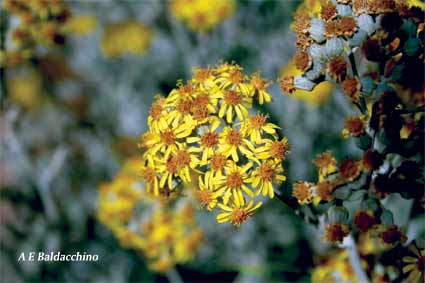
SILVER RAGWORT – Kromb il-Baħar Isfar
The Silver Ragwort is a dwarf shrub growing to about 100 cm high. It is indigenous to the Mediterranean and a perennial, that is, it grows and blooms during spring and summer, then dries up in autumn and winter, and springs back to life again from its root stock. It is tolerant to extreme conditions, and is a water conservation species that also thrives in environments with a very high concentration of salt. The leaves are lance-shaped, as is the stem, and are covered with long, white matt hair. It grows in rock fissures, walls and cracks, and is very common near the sea, flowering in spring and summer.
The flower head is a compact flower, an inflorescence, that is, a group or cluster of yellow flowers arranged on a stem that is composed of a main branch or an arrangement of branches. The yellow flower is 4 cm in diameter. It is also used in cultivation and landscaping, though unfortunately not in the Maltese Islands.
The Silver Ragwort is also used in herbal medicine, mostly for eye treatments, such as cataracts and for treating inflammation of the membrane that lines the inner surface of the eyelid and the exposed surface of the eyeball.
CONCLUSION
This is just a glimpse of a few of the common wild flowers one can discover while walking along Dingli Cliffs. The floral richness of Dingli Cliffs, and the different natural habitats, makes Dingli Cliffs so important that they are regarded as a special habitat of EU Community Interest. Dingli Cliffs are a Special Area of Conservation declared under the Habitats Directive, thus forming part of the European Union’s Natura 2000 Network.
Besides adorning and filling the natural environment with so many colours, wild flowers can also embellish our urban environment if they are used in urban landscaping, or planted in front- and back-gardens. There are many other species of wild flowers, though unfortunately these are not appreciated but are neglected and ignored. This information is intended to help create greater awareness of the natural wild flora of the Maltese Islands.




 Posted by Baldacchino Alfred E.
Posted by Baldacchino Alfred E.